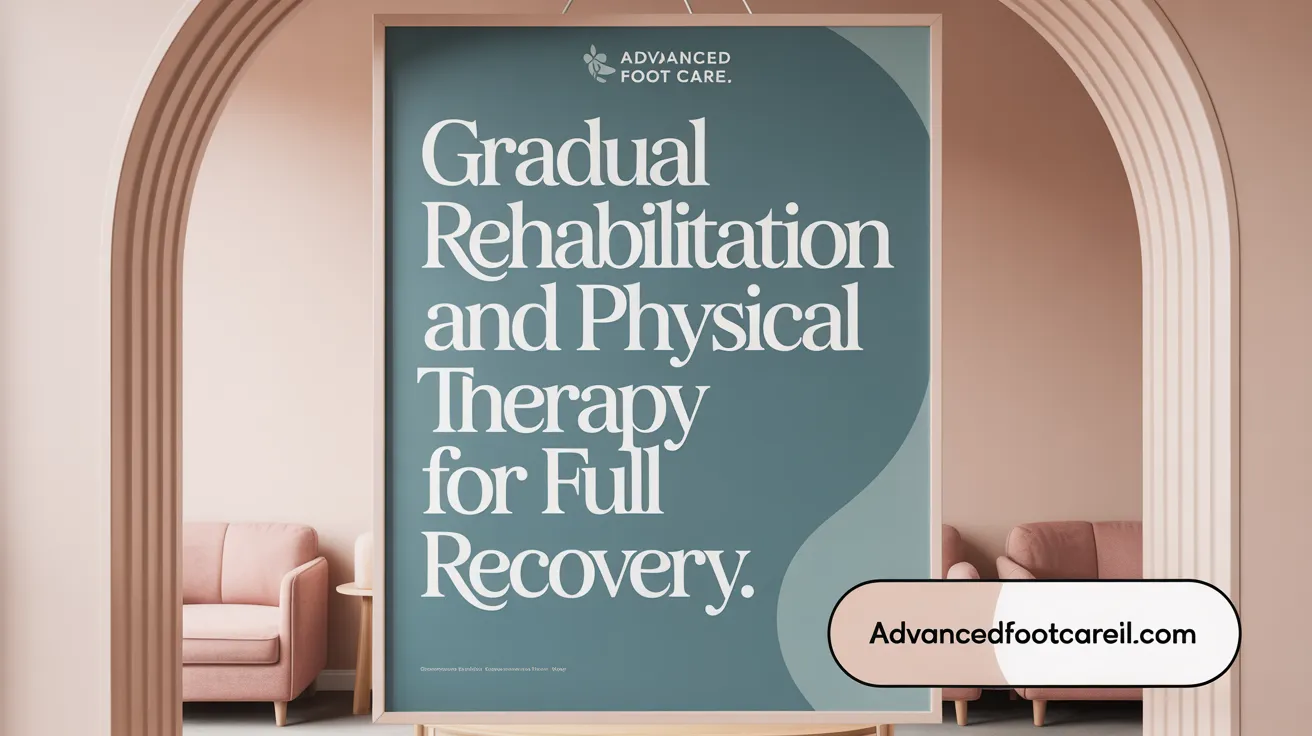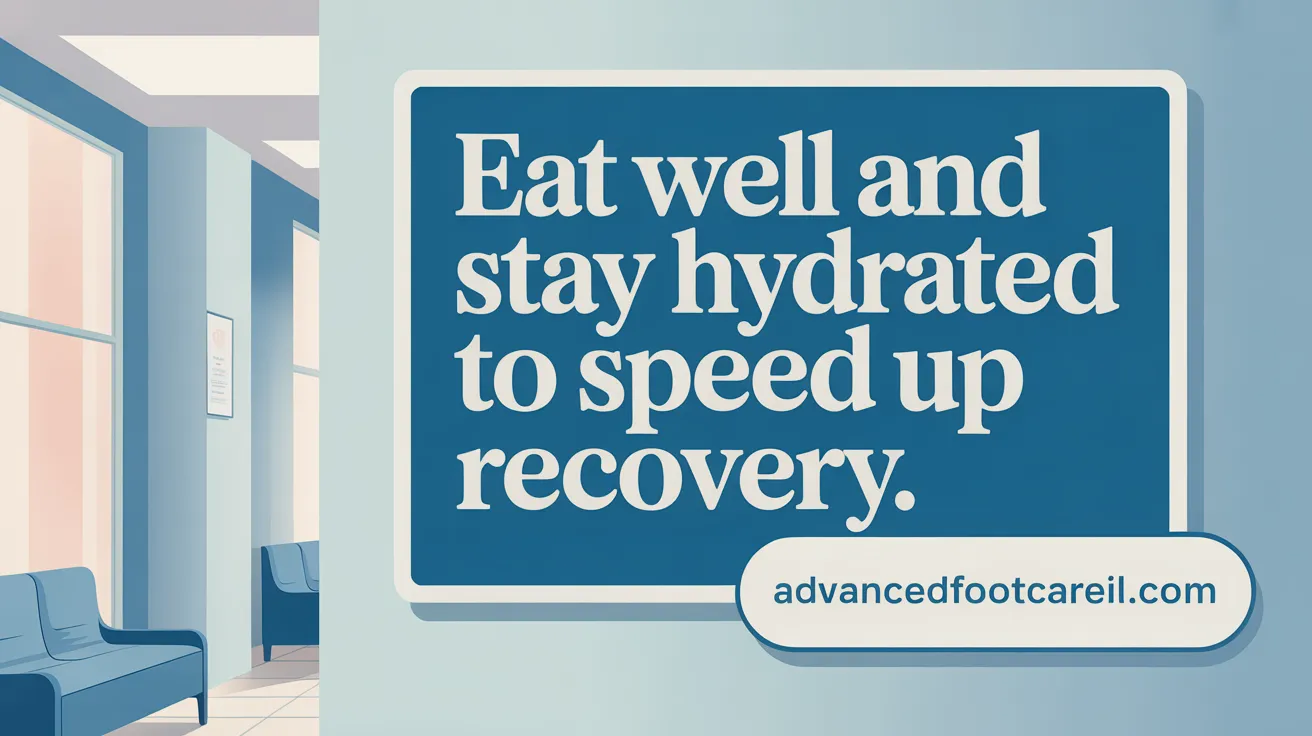Why Recovery Matters After Foot Procedures
Recovering from foot surgery can be a complex and gradual process that involves more than just resting the foot. Understanding the essential steps to promote healing, reduce complications, and regain mobility is crucial for a faster and smoother recovery. This article outlines key strategies based on expert guidance and research to help you navigate post-operative care with confidence and ease.
Prioritize Rest, Elevation, and Pain Management

What is the importance of rest in foot surgery recovery?
Rest is vital after foot surgery because it allows the body's tissues to heal properly, preventing complications and reducing the risk of reinjury. Getting adequate sleep supports natural repair processes and helps control inflammation, which is crucial during the early recovery phase (No. 1 secret to foot and ankle surgery recovery, Rest to prevent complications and reinjury, Proper rest after foot surgery, Importance of sleep in tissue healing).
How does elevating the foot aid recovery?
Elevating the operated foot above heart level is a simple yet effective way to reduce swelling and pain. This position promotes better circulation by reducing fluid buildup in the foot and ankle. Elevation is especially important during the first two weeks after surgery when swelling is most significant (Elevating the foot after surgery, Benefits of foot elevation post-surgery, Controlling post-op swelling with elevation, Foot and ankle surgery wound care).
How should ice packs be used during recovery?
Applying ice for about 20 minutes at a time can help manage inflammation and alleviate pain. It is essential to protect the skin by wrapping the ice pack in a cloth or using a thin plastic-covered bag. Ice should be used after the nerve block from surgery wears off to avoid masking pain signals, and care must be taken to avoid frostbite (Using ice for pain relief, Ice pack application tips for foot surgery, Ice packs after nerve block, Pain management and ice application).
How is pain best managed after foot procedures?
Effective pain control usually involves taking prescribed medications, including NSAIDs or opioids, as directed by the healthcare provider. Starting pain medication before the nerve block subsides ensures comfort. Combining medication with elevation and ice application enhances pain relief. Patients should closely monitor their pain and seek medical attention if pain worsens or becomes severe (Pain management after foot surgery, Taking pain medication on schedule, Pain relief techniques post foot surgery, Managing pain and swelling post surgery).
Create a Safe, Accessible Home Environment
How can home modifications support recovery after foot surgery?
Preparing the home significantly aids safe and smooth recovery after foot surgery. Key steps include decluttering pathways and removing obstacles to prevent falls. Ensuring good lighting throughout the living space enhances visibility and reduces trip hazards.
Organizing frequently used items within easy reach limits unnecessary movement and strain on the healing foot. Installing safety features such as grab bars in bathrooms and along stairways, as well as placing non-slip mats on floors, provides additional support and stability.
Why is having a support system important?
A strong support system of family, friends, or caregivers is essential during the early stages of recovery. Caregivers assist with daily activities, transportation to medical appointments, meal preparation, and medication management.
Emotional support helps patients adhere to post-surgical instructions, reduces stress, and improves overall recovery outcomes. For more on caregiver support and recovery, see Recovering from Foot or Ankle Surgery.
How to organize recovery essentials
Setting up a dedicated recovery spot equipped with necessary supplies such as medications, water, phone, and remote controls helps patients keep everything within reach. This reduces the need for frequent movement and the risk of injury. Learn more about home preparation for surgery recovery.
Installing grab bars and non-slip mats
Grab bars installed near the toilet, shower, and stairs provide dependable handholds. Non-slip mats should be used especially in wet areas like bathrooms and kitchens for added traction.
Through careful home preparation and fostering a reliable support network, patients can create a safe and accessible environment that promotes healing and independence during foot surgery recovery.
Follow Post-Surgical Care Instructions Precisely

How should the surgical site be cared for to avoid infection?
Proper care of the surgical site is essential to prevent infections after foot or ankle surgery. Keeping the incision area clean and dry is crucial. Patients should protect dressings during bathing by covering them with waterproof covers or secure plastic bags. Avoiding moisture exposure helps maintain a sterile environment around the wound (Foot and ankle surgery wound care, Keeping surgical area clean).
Patients must watch for any signs of infection such as increased redness, discharge from the wound, or the onset of fever. Promptly reporting these symptoms to the healthcare provider ensures early treatment and reduces the risk of complications (Signs of infection after foot and ankle surgery, Preventing infection after foot and ankle surgery.
What is the role of assistive devices and follow-up visits?
Assistive devices prescribed after surgery—like crutches, knee scooters, or post-operative shoes—play a vital role in limiting weight-bearing on the operated foot. Using these devices as instructed helps protect the surgical site, promotes proper healing, and prevents reinjury (Mobility aids following foot and ankle surgery, Postoperative mobility aids for foot surgery).
Attending all scheduled follow-up appointments, typically within 1 to 3 weeks after surgery, allows surgeons to evaluate healing progress. These visits offer opportunities to remove or change dressings, monitor for complications, and adjust recovery plans. Early identification of any issues ensures timely interventions and supports a smoother recovery journey (Importance of follow-up appointments, Follow-up care after foot surgery).
Adhering strictly to these post-surgical care instructions is fundamental to achieving the best outcomes, minimizing risks, and returning to normal activities safely and efficiently (Post-surgical instructions, Recovery from foot or ankle surgery).
Engage in Gradual Rehabilitation and Physical Therapy

Why is physical therapy important after foot surgery?
Physical therapy plays a crucial role in restoring strength, flexibility, and range of motion following foot surgery. Tailored conditioning programs focus on specific foot and ankle muscles, helping to reduce stiffness and improve stability. This targeted approach not only supports recovery but also helps prevent future injuries by addressing muscular imbalances and improving proprioception.
What types of exercises are typically involved?
Rehabilitation exercises usually include:
- Stretching: Heel cord stretches and towel stretches to enhance flexibility.
- Strengthening: Calf raises and towel curls to build muscle strength.
- Mobility: Ankle range of motion drills help maintain joint flexibility.
- Balance training: Activities using support surfaces and equipment like tennis balls or resistance bands improve stability.
These exercises are performed gradually and carefully to avoid pain, with progression guided by healthcare professionals. For more about post-surgery rehabilitation and exercises, see Foot and Ankle Rehabilitation and Foot and ankle rehabilitation exercises.
How is weight bearing managed post-surgery?
Weight bearing is closely monitored and adapted based on the surgical procedure. Initially, patients may be instructed to avoid putting weight on the foot (non-weight bearing) or limit it (partial weight bearing) for 2 to 8 weeks. Gradual transition to full weight bearing is supervised by the medical team, minimizing the risk of reinjury while promoting healing. Assistive devices such as crutches or knee walkers support mobility during this phase. For detailed guidance on weight-bearing protocols and mobility aids after surgery, see Using crutches and walkers post surgery and Recovery from foot or ankle surgery.
Gradual rehabilitation integrating these exercises and weight-bearing protocols ensures effective recovery, helping patients regain natural movement and return safely to daily activities.
Support Recovery with Proper Nutrition and Hydration

How does nutrition impact foot surgery recovery?
Proper nutrition plays a vital role in ensuring a smooth recovery after foot surgery. A balanced diet rich in protein, essential vitamins such as A, C, and D, and minerals like calcium, iron, and zinc provides the building blocks needed for tissue repair and enhances immune function. These nutrients support healing processes by helping the body rebuild muscles, bones, and skin at the surgical site. For more details, see Nutrition for Foot Surgery Recovery.
What are good dietary choices during recovery?
Including a variety of nutrient-dense foods can accelerate healing. Protein-rich foods supply amino acids crucial for muscle and tissue regeneration. Incorporating fruits and vegetables provides antioxidants and vitamins essential in reducing inflammation and supporting recovery. Complex carbohydrates—like oatmeal, sweet potatoes, quinoa, and whole grains—offer consistent energy to meet the increased metabolic demands during healing. Additionally, anti-inflammatory fats found in fatty fish, nuts, seeds, and coconut oil help minimize swelling and support cellular repair. For an overview of a healthy diet to support foot surgery recovery, refer to Nutrition for foot surgery recovery.
Why is hydration important?
Adequate hydration is another cornerstone of effective recovery. Drinking at least eight glasses of water daily assists in flushing out toxins, promoting elimination of anesthesia medications from the body, and maintaining regular bowel function. Staying well-hydrated also supports circulation and reduces the risk of post-operative complications like constipation and delayed healing. For hydration tips and inflammation management after surgery, see Nutrition to help you recover after foot surgery.
Manage Common Recovery Challenges and Long-Term Expectations

What symptoms are normal after foot surgery and which require attention?
After foot and ankle surgery, it is typical to experience pain, swelling, and bruising after surgery, discoloration, minor bleeding, and sometimes low-grade fevers. These signs are part of the normal healing process. However, certain symptoms warrant prompt medical attention. These include severe or unrelenting pain despite medication and elevation, high fever, foul odors or excessive drainage from the surgical site, skin color changes such as pale or dark black hues that suggest poor circulation, and swelling that persists or worsens beyond expected timelines.
What is the typical recovery timeline?
Recovery generally begins with 1 to 2 weeks of wound healing, during which the foot should be kept elevated and protected. Non-weight bearing typically lasts 4 to 6 weeks, although this depends on the specific surgery performed. Rehabilitation can extend for several months, with most patients achieving significant improvement within 3 to 6 months. Full recovery, including swelling resolution and return to normal activities, may take up to a year or more, especially after complex surgeries. For detailed expectations, see the foot and ankle surgery recovery timeline.
How important is psychological support during recovery?
The recovery journey can be physically and emotionally challenging. Emotional well-being is crucial, as patients must cope with physical restrictions, slow progression, and lifestyle adjustments. Patience and realistic expectations are important. Support from caregivers, family, and friends helps with daily tasks and provides encouragement. Engaging in mental activities and maintaining a positive outlook can significantly improve recovery experiences.
What lifestyle changes support long-term outcomes?
Adopting certain lifestyle habits enhances recovery durability and foot health. Wearing supportive, well-fitted footwear with adequate arch support and room for toes reduces strain and re-injury risk. Quitting smoking and avoiding nicotine improve blood flow and healing. Maintaining a healthy weight reduces pressure on the foot and joints. Low-impact exercises, such as swimming or cycling, strengthen muscles without overloading the foot. Following medical guidance on activity levels and attending follow-up appointments ensures ongoing care and prevention of complications.
Achieve a Successful Recovery with Knowledge and Support
Recovering from foot surgery requires a multifaceted approach that combines rest, careful wound care, rehabilitation, and lifestyle adjustments. By following these expert tips — prioritizing rest and elevation, preparing your home environment, adhering to post-operative instructions, engaging in tailored physical therapy, supporting your body with good nutrition, and managing expectations — you can navigate the road to recovery more confidently and effectively. Remember that recovery timelines vary, and staying in close contact with your healthcare team ensures challenges are addressed promptly. With proper care and patience, you can look forward to regaining mobility and resuming your daily activities with improved comfort and function.
